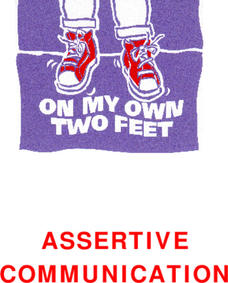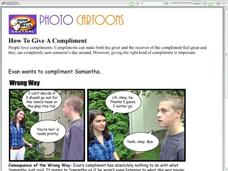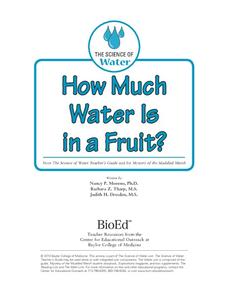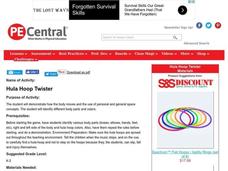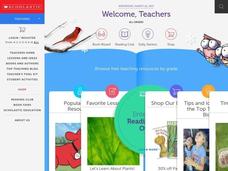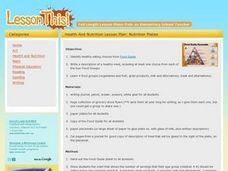Baylor College
Defending Against Microbes
In the preceding lesson from the unit, beginning biologists discovered that microorganisms are everywhere, so the question follows, why are we not sick all of the time? Class members read and discuss an article in small groups about...
Department of Education (Ireland)
Assertive Communication
Assertive communication is an acquired skill. Teaching young people to ask for what they need and to believe that they have a right to ask is at the core of a unit on assertive communication. Over the course of the unit, middle and high...
Baylor College
Breathing Machine
Take a deep breath and have your class construct working models of a lung! Using 500ml plastic bottles as the chest cavity, and balloons for the lung and the diaphragm, learners work in groups to make a model. The models help them to...
Baylor College
Water: Post-Assessment
Very simply, the science class will discuss what they have learned during The Science of Water unit and take a multiple-choice post-assessment quiz. A few other closing activities are suggested for you to choose from, such as having...
Social Skills Central
Photo Cartoons: How To Give A Compliment
Help learners develop the ability to offer appropriate, meaningful compliments to others—an essential social skill. Here you'll find a quick photo cartoon illustrating a right and wrong way to give a compliment, as well as a brief...
Baylor College
How Much Water Is in a Fruit?
Compare the volume of an orange to the volume of liquid that can be extracted out of it. Also compare the mass of an apple before and after it has been dried out. In both of these activities, children find that there is an appreciable...
Baylor College
Plant Parts You Eat
Plants provide a variety of delicious foods essential for human survival. In the fourth lesson of this series on food science, young scientists investigate common fruits, vegetables, and grains in order to determine which plant part is...
Baylor College
Bio Build-up
Trace pollutants through the environment in the seventh instructional activity of this series on the science of food. Looking at a picture of the plants and animals in an aquatic ecosystem, learners use dot stickers to represent harmful...
BioEd Online
Muscles and Bones: Nutrition
Got milk? Or almonds, sardines, or tofu? Calcium is important throughout life, but especially so for developing bodies. If teens do not consume enough calcium while they are growing, they are at a much higher risk of osteoporosis and...
Baylor College
What is Blood Pressure?
Find out how we describe the force created by the blood against the walls of the vessels in a heart-pumping lesson! As part of a unit on the heart and circulatory system, cardiology kids use a blood pressure monitor to find their...
Curated OER
How Can You Be a Revolutionary?
Tenth graders identify priorities in human rights for children. They discuss the role the United Nations has in bringing nations together to work for peace and development. They create a list of imperatives that would address oversights...
Curated OER
How Hard Is Your Heart Working?
Students observe the differences in their pulse from when they are sitting to when they have been doing the "Hokey-Pokey." In this heart health lesson plan, students take and record their pulse after they have been doing a quiet...
Curated OER
Favorite Foods
Pupils explore human health by completing food choice worksheets. In this world hunger lesson, students discuss the importance of eating three daily meals and how to feed the underprivileged through charities and soup kitchens. Pupils...
Curated OER
Hula Hoop Twister
Young scholars demonstrate how the body moves and the use of personal and general space concepts.Students identify different body parts and colors.young scholars identify various body parts (knees, elbows, hands, feet, etc), right and...
Curated OER
Think Your Drink
Students examine their fluid intake and the types of beverage they drink. In this adult health instructional activity, students describe the risks of too much sugar in their drink. They brainstorm ways to cut back on sodas and drink...
Curated OER
BELT-ABOUTS LESSON 2
Students explain why safety belts don't fit all children. They decribe the correct way to wear a safety belt. Students explain why incorrect belt fit can be dangerous. They are shown a diagram of the human body. Students identify the...
Curated OER
Let's Learn the Flu Facts
Students explore the common causes for colds and the flu. After discussing cold and flu symptoms, students complete a worksheet. They discuss ways to stay healthy and prevent colds and flu. Afterwards, students complete a puzzle...
Curated OER
Welcome to WIC
Students summarize the benefits and services offered by WIC. In this adult health lesson, students review what fruit and vegetables are covered by WIC. They practice shopping using their checks.
Curated OER
Scooter Signal
Students practice the use of hand signals to designate right or left turns. In this safety lesson plan, students ride a scooter following paths set up to look like sidewalks and roads. Students practice forming the proper signals prior...
Curated OER
Nine Months in Six Weeks
Student study possible effects the mother's nutritional habits will have on her baby. They see how important it is to eat right and examine a regular diet for a pregnant woman or one for a woman with diabetes or other physical problems.
Curated OER
Healthy Heart
Students explore how the heart works, examine pictures of a troubled heart, and discuss how to keep the heart healthy.
Curated OER
The Impact of War on Children
Young scholars discover how students are affected by wars in their country. After reading a UNISEF report, they work together to summarize the article and answer comprehension questions. They examine the short- and long-term affects of...
Curated OER
Nutrition Plates
Learners investigate healthy eating habits by studying the food pyramid. In this personal health lesson, students write a recipe for a healthy meal including one item from each section of the four food groups. Learners...
World Health Organization
Sun Protection
Primary graders become sun scientists and conduct experiments to learn about the beneficial and harmful effects of the sun and UV radiation. They also investigate their personal sunburn danger zones and learn about how to protect...



